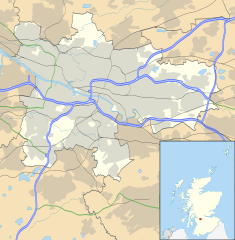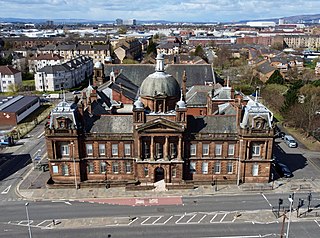
Govan Town Hall is a former municipal facility on Govan Road, Govan, Scotland. The town hall, which was the headquarters of Govan Burgh Council, is a Category B listed building.
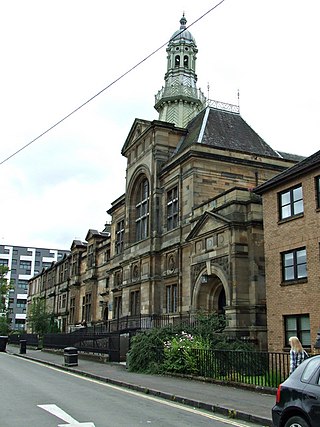
Partick Burgh Hall is a municipal facility in Burgh Hall Street, Partick, Scotland. The hall, which was the headquarters of Partick Burgh Council in the early 20th century, is a Category B listed building.
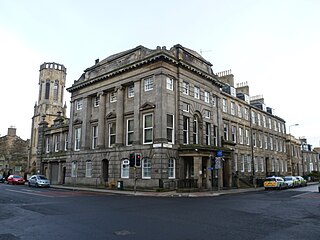
The Old Town Hall is a municipal building in Queen Charlotte Street, Leith, Scotland. The old town hall, which was the meeting place of Leith Burgh Council, is now used as a police station. It is a Category A listed building.
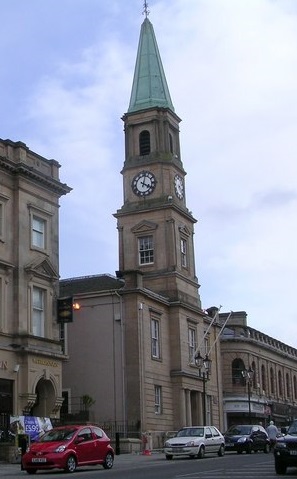
Airdie Town House is a municipal building in Bank Street, Airdrie, North Lanarkshire, Scotland. The town house, which was the headquarters of Airdrie Burgh Council, is a Category B listed building.

The Municipal Buildings are based on the north side of Buccleuch Street, Dumfries, Dumfries and Galloway, Scotland. The structure, which was the headquarters of Dumfries Burgh Council, is a Category C listed building.

Rothesay Town Hall and County Buildings is a former municipal building in Castle Street, Rothesay, Scotland. The structure, which was the meeting place of Rothesay Burgh Council and of Bute County Council, is a Category B listed building.

Troon Town Hall is a municipal building in Ayr Street, Troon, Scotland. The structure, which serves as the meeting place of Troon Community Council, is a Category B listed building.

The Town Buildings, also known as the Municipal Buildings, are in Fore Street, Port Glasgow, Scotland. The structure, which served as the meeting place of Port Glasgow Burgh Council, is a Category A listed building.

Hawick Town Hall is a municipal building in the High Street, Hawick, Scotland. The structure, which served as the meeting place of Hawick Burgh Council, is a Category A listed building.

The Municipal Buildings are based on the north side of Princes Street East in Helensburgh, Scotland. The structure, which served as the meeting place of Helensburgh Burgh Council, is a Category B listed building.

The Municipal Buildings are based in Buccleuch Street in Dalkeith, Scotland. The structure, which served as the meeting place of Dalkeith Burgh Council, is a Category B listed building.

The Justiciary Buildings is a judicial complex in the Saltmarket in Glasgow, Scotland. The complex, which operates in conjunction with similar facilities in Edinburgh and Aberdeen, is dedicated for the use of the High Court of Justiciary, which is the supreme criminal court in Scotland. It is a Category A listed building.

Gatehouse of Fleet Town Hall is a former municipal building in the High Street in Gatehouse of Fleet, Dumfries and Galloway, Scotland. The structure, which is now in private residential ownership, provides access to a fine ornamental garden behind the town hall.
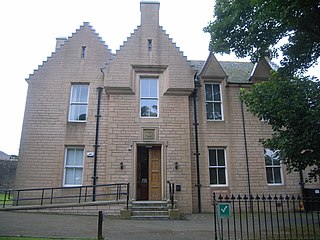
Kirkwall Sheriff Court is a judicial structure in Watergate, Kirkwall, Orkney, Scotland. The structure, which was the headquarters of Orkney County Council and is currently used as a courthouse, is a Category C listed building.
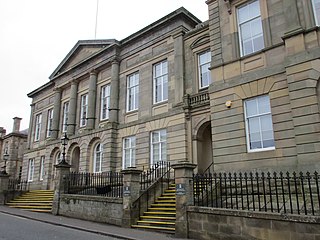
Lanark Sheriff Court is a judicial building in Hope Street, Lanark, South Lanarkshire, Scotland. The building, which continues to serve as the local courthouse, is a Category B listed building.

Lanark Tolbooth is a municipal building in Hope Street, Lanark, South Lanarkshire, Scotland. The building, which now operates as an arts and heritage centre, is a Category B listed building.

Whiteinch Burgh Hall is a municipal building on Victoria Park Drive South in Whiteinch, part of Glasgow, Scotland. The burgh hall, which is currently derelict, is a Category B listed building.

Ardrossan Civic Centre is a municipal building in Glasgow Street in Ardrossan, a town in North Ayrshire, Scotland. The building, which was previously the offices and meeting place of Ardrossan Burgh Council, is currently used as a masonic hall.

Dalkeith Tolbooth is a historic building on the High Street in Dalkeith, Scotland. The building, which was previously the meeting place of the burgh council, is a Category A listed building.

Partick Police Station, previously known as Partick Police Court and also as the Old Burgh Hall, is a former municipal and judicial building on Anderson Street in Partick, Scotland. The building, which was previously the meeting place of the burgh council and now serves as the offices of the Centre for Sensory Impaired People, is a Category B listed building.

